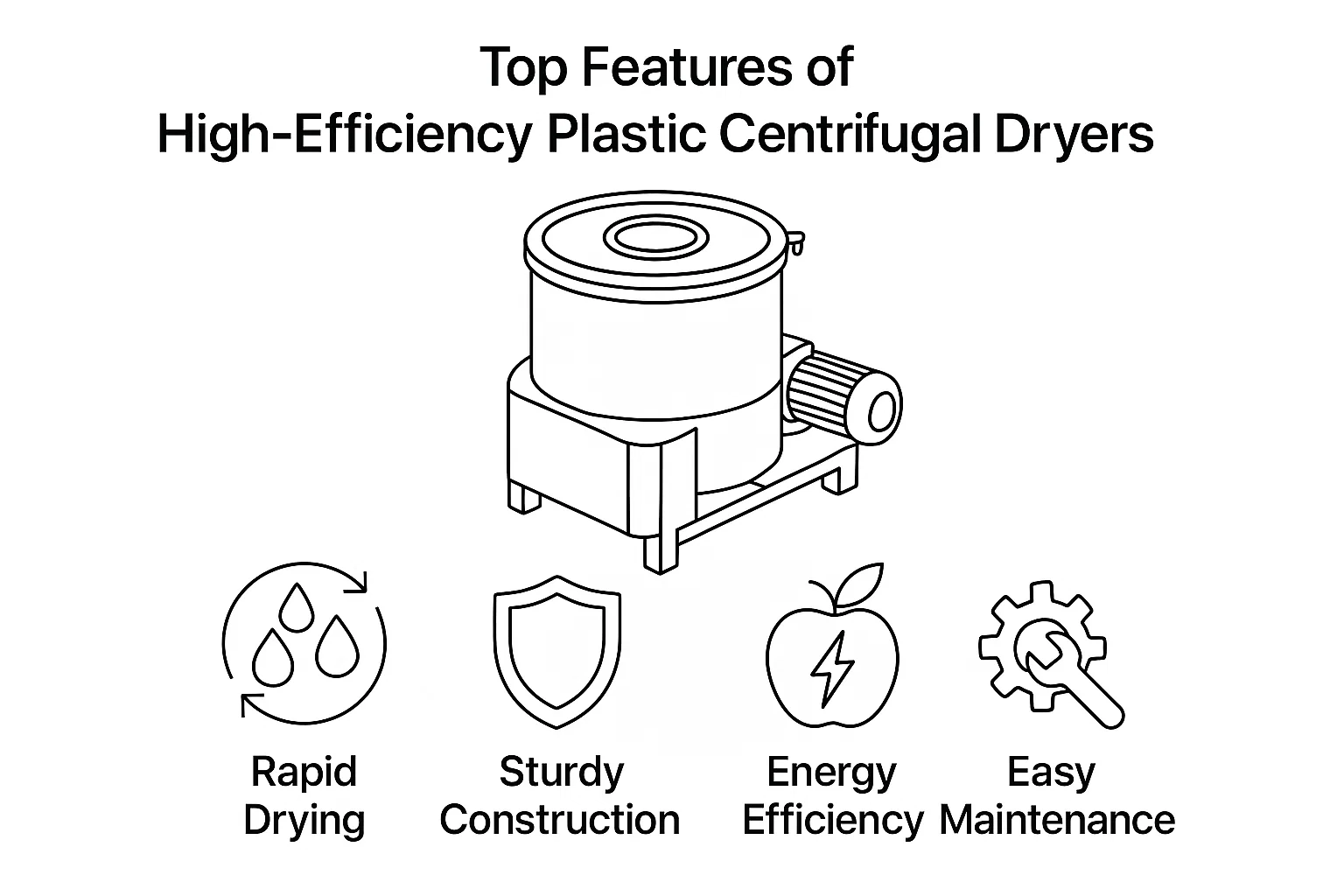Why Precision Dewatering Matters in Plastic Recycling
In the competitive world of plastic recycling, the difference between high-value pellets and rejected material often comes down to one factor: moisture content. Whether you are processing post-consumer PET bottles, HDPE milk jugs, or PP battery cases, water is the enemy of the extrusion process. Excess moisture leads to bubbles, structural execution flaws, and hydrolytic degradation in the final product.
C'est ici que le sécheur centrifuge en plastique becomes the heartbeat of the washing line. It is not merely a machine that spins; it is a precision-engineered component designed to mechanically remove surface water from plastic flakes and regrinds using intense centrifugal force. For plant managers and facility owners, selecting a dryer with the right features is paramount to ensuring operational uptime and product quality.
Below, we delve into the critical features that define a high-quality industrial centrifugal dryer and why they matter for your bottom line.
1. High-Speed Rotor Balancing and Design
The core of any centrifugal dryer is its rotor. To achieve the high RPMs necessary for effective dewatering (often between 1,200 and 1,800 RPM), the rotor must be impeccably balanced.
Dynamic Balancing
A buyer-centric evaluation of a dryer starts with its stability. Superior machines undergo rigorous dynamic balancing testing. If a rotor is unbalanced, it causes excessive vibration. Over time, this vibration destroys bearings, cracks the machine housing, and leads to frequent, costly downtime. A well-balanced rotor ensures smooth operation, reduced noise levels, and a significantly longer lifespan for the equipment.
Paddle Geometry and Adjustability
The paddles (or blades) attached to the rotor are responsible for transporting the plastic material and generating the impact force that shakes off water. High-end dryers feature aggressive paddle geometries that maximize the dwell time of the plastic inside the screen area without causing clogging. Furthermore, adjustable paddles allow operators to fine-tune the pitch. This customization is vital because different plastics (e.g., light films vs. heavy rigid flakes) require different transport speeds through the machine to achieve optimal dryness.
2. Durable Material Construction
Industrial recycling is a harsh environment. Sand, metal contaminants, and abrasive plastics wear down machinery quickly. When evaluating a sécheur centrifuge en plastique, the construction materials are a direct indicator of the machine’s longevity.
Wear-Resistant Steel
Standard carbon steel blades will wear down within weeks when processing dirty or abrasive materials like PET flakes. Leading manufacturers utilize wear-resistant materials, such as Hardox steel or reinforced stainless steel, for the rotor blades. Some units even feature carbine-tipped blades for extreme durability.
Stainless Steel Contact Parts
Corrosion is a major concern in a wet environment. All parts of the dryer that come into contact with water and wet plastic—specifically the screen basket, the housing, and the discharge chute—should be manufactured from 304 or 316 stainless steel. This prevents rust contamination in your plastic stream and ensures the structural integrity of the machine over decades of use.
3. Advanced Bearing Protection Systems
The most common point of failure in dewatering machines is the bearing assembly. Because the machine deals with high volumes of water and fines (small plastic particles), there is a high risk of these elements entering the bearing housing.
External Bearing Housing
Top-tier engineering separates the bearing housing from the wet drying chamber. By placing the bearings outside the main machine body, manufacturers ensure that water cannot easily penetrate the lubrication system.
Double Sealing Mechanisms
Beyond placement, the sealing technology is crucial. Look for dryers equipped with labyrinth seals or air-purge systems. An air-purge system continuously blows compressed air into the gap between the shaft and the seal, creating positive pressure that physically prevents water and dust from entering the bearing assembly. This feature alone can save thousands of dollars in maintenance costs annually.
4. Optimized Screen Configuration
The screen basket surrounds the rotor and allows water to escape while keeping the plastic inside. The design of this screen significantly impacts both drying efficiency and maintenance ease.
Polygon vs. Round Screens
While traditional dryers use cylindrical (round) screens, modern high-efficiency models often utilize polygon (hexagonal or octagonal) screen designs. The polygon shape creates a “pulsing” effect as the plastic rotates. As the material hits the flat sides of the screen, it tumbles more effectively, releasing trapped water and preventing the material from simply sliding along the wall. This results in lower moisture content.
Self-Cleaning Capabilities
Screen blinding (clogging) is a major headache for operators. High-quality dryers incorporate automatic cleaning systems, often using air jets or water sprays to clear the screen holes during operation. Additionally, the machine should be designed for easy screen removal. Split-screen designs or easy-access doors allow maintenance teams to swap or clean screens in minutes rather than hours.
5. Moisture Reduction Efficiency
Ultimately, you are buying a dryer to dry material. The industry standard for a high-quality mechanical dryer is the ability to reduce moisture content to 2% or less for rigid plastics (like PE/PP flakes) and 1% or less for PET flakes, assuming proper upstream washing.
This efficiency is achieved through a combination of:
- High G-Force: Sufficient speed to physically strip water from the surface.
- Airflow Management: Many advanced centrifugal dryers act as substantial air movers. The design should encourage airflow through the material, which aids in evaporation and transport.
- Throughput Consistency: The machine must maintain these moisture levels even at high capacity. A dryer that only works well at 50% capacity creates a bottleneck in your production line.
6. Energy Efficiency and Drive Systems
In an era of rising energy costs, the efficiency of the motor and drive system is a significant consideration for ROI.
Soft Start and VFD Integration
Starting a heavy, high-inertia rotor requires a massive spike in energy. Dryers equipped with Soft Starters or Variable Frequency Drives (VFDs) manage this ramp-up smoothly, reducing peak energy demand and mechanical stress on the drive belt and motor. Furthermore, a VFD allows operators to adjust the RPM based on the specific material density, saving energy when running lighter loads.
Direct Drive vs. Belt Drive
While belt drives are common and offer shock absorption, direct drive systems (where the motor is directly coupled to the rotor) offer higher energy transfer efficiency and eliminate the maintenance associated with belt tensioning and replacement. Depending on your facility’s maintenance capabilities, choosing the right drive system is essential.
7. Ease of Maintenance and Accessibility
Downtime kills profitability. A machine that is difficult to service will inevitably be neglected, leading to performance drops. Buyer-centric design focuses on “tool-free” or “quick-tool” access.
Hydraulic Opening Mechanisms
Large industrial dryers are heavy. Manual opening of the housing for cleaning is labor-intensive and dangerous. Premium models feature hydraulic or pneumatic rams that lift the upper housing or screen basket with the push of a button. This encourages frequent cleaning and inspection, ensuring the machine runs at peak performance.
Modular Components
Wear parts—such as blades, screens, and bearings—should be modular and standard. Proprietary parts that have long lead times can shut down a plant for weeks. Energycle prioritizes designs where consumables are easily sourced and quickly replaced.
Conclusion: Investing in Reliability
Choisir le bon sécheur centrifuge en plastique is not just about the initial purchase price; it is about calculating the Total Cost of Ownership (TCO). A cheaper machine with poor balancing, weak bearings, or inefficient dewatering will cost significantly more in energy, maintenance, and rejected plastic pellets over its operational life.
At Energycle, we understand the rigors of the recycling industry. Our equipment is designed with the features listed above—robust metallurgy, smart bearing protection, and high-efficiency rotor dynamics—to ensure your line keeps running and your pellets remain dry.
Whether you are upgrading an existing line or building a new facility, prioritize these features to secure a competitive edge.
Ready to optimize your drying process?
Contact Energycle today to discuss your specific material requirements, or request a quote to see how our advanced dewatering solutions can boost your production quality.



